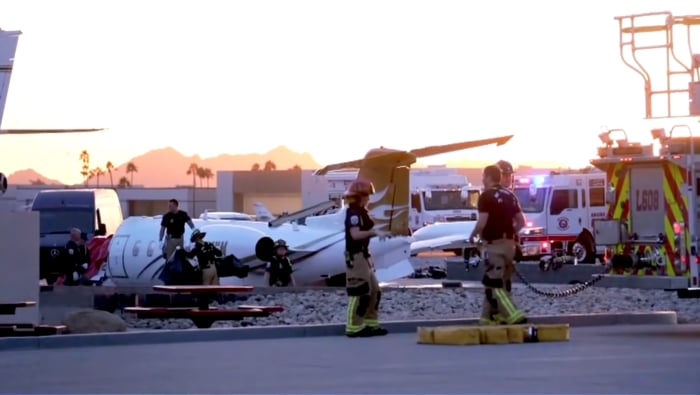AINalerts will not publish tomorrow in observance of the U.S. Independence Day holiday. Publication will resume on Monday, July 7.
|

Eighteen fatal turbine business aircraft accidents worldwide claimed the lives of 81 passengers and crew in the first half of 2025, up from 17 fatal accidents and 54 fatalities in the first six months of 2024, according to preliminary data gathered by AIN.
Notably, U.S.-registered business jets made up the only segment to complete the first six months with fewer fatalities than in the same period last year. Nine people lost their lives in three U.S.-registered business jet accidents last year versus eight people who died—also in three accidents—this year. These included a parked Gulfstream G200 struck by a U.S.-registered Learjet 35A that veered off the runway while landing in Scottsdale, Arizona, on February 10, killing the Learjet pilot; an N-numbered Cessna Citation CJ2 on a planned ferry flight that crashed during climb out on March 13, killing the sole-occupant pilot; and a Citation S550 that crashed on an approach near San Diego on May 22, killing all six onboard. All three occurred under Part 91.
Five fatal accidents of U.S.-registered business turboprops resulted in 18 deaths in the first half of the year, compared with seven deaths in four accidents in the same period last year. Half of the 40 fatalities from six accidents involving non-U.S.-registered business turboprops in the first six months includes 20 who died when their chartered Ugandan-registered Beech 1900D crashed in South Sudan.
|
In my last blog, I introduced a discussion of cancer and its many implications for pilots. Of the pilots with a cancer diagnosis, many receive a favorable prognosis—that their cancer is likely going to be survivable—and the reassurance that it should not cause permanent disability. That news comes with quite a sense of relief.
In those cases, inevitably, a pilot quickly transitions their thoughts back to aviation. The understandable fear is that their aviation days are over. And, even if medical certification might be possible once the cancer has been treated, is the process going to morph into a proverbial “goat rope” of battles with the FAA?
In the past, virtually every cancer (except for some of the less severe variants of skin cancer) was followed by the FAA under a special issuance authorization (SIA) with complicated, ongoing, and extensive documentation. Cancers that have metastasized (spread) and are more complicated in their treatment and prognosis will, of course, be followed carefully by the FAA.
However, the light at the end of the tunnel here is that many cancers can currently be followed by the AME under the Conditions the AME Can Issue (CACI) program. An extensive and growing number of medical conditions that previously required an SIA can now be followed under CACI.
|
Embraer’s executive jets division continues to ramp up its manufacturing tempo with a 36% year-over-year increase in aircraft production during the first half. The Brazilian airframer handed over 61 business jets in the first six months, 16 more than during the same span a year ago. For the year, the manufacturer is forecasting 145 to 155 business jet deliveries.
In the midsize business jet segment, it saw a 46% increase in deliveries, handing over 15 Praetor 600s and eleven 500s, compared to eight and six, respectively, in the first half of 2024, while production of its light Phenoms improved by four over the same span.
In the second quarter alone, Embraer delivered 38 business jets, with the 17 Praetors handed over more than doubling those in second-quarter 2024. This compares to 27 business jet deliveries in the same quarter last year.
“We are very excited about the 41% increase in Embraer Executive Jets deliveries to our valued customers in the second quarter, as a direct result of production leveling, smart asset utilization, and key investments we have made to expand our industrial capacity,” Embraer Executive Jets president and CEO Michael Amalfitano told AIN. “In this period, it is worth noting the significant increase in deliveries of the midsize Praetor 500 and super-midsize Praetor business jets.”
|
Volato has completed the sale of GC Aviation, including its FAA Part 135 air carrier certificate, for $2 million in cash, the company announced this week. The divestiture marks a shift in Volato’s business model, reducing its direct flight operations in favor of a platform-based approach, meaning charter brokering.
Volato described the decision as part of a long-term strategy to exit capital-intensive flight service operations and instead work with third-party operators. The firm’s proprietary platforms support fractional ownership, charter, aircraft leasing, and other private aviation services.
The buyer of GC Aviation was not disclosed. Volato had previously used the certificate to conduct its managed aircraft operations. With this move, the Atlanta-based company aims to concentrate on its proprietary Mission Control software, Vaunt experiential travel platform, and expanding aircraft trading and leasing activities.
“Divesting GC Aviation was a deliberate move to concentrate on the areas of our business with the highest growth potential and strongest returns,” said Matt Liotta, co-founder and CEO of Volato. “It allows us to deploy capital more effectively, strengthen our balance sheet, and accelerate platform-driven opportunities that expand value for our customers and shareholders.”
According to the company, the proceeds from the sale will be used to fund expansion across Mission Control, Vaunt, and its aircraft trading and leasing efforts.
|
Sponsor Content: Duncan Aviation
Duncan Aviation was recognized as the Veterans of Foreign Wars National and Nebraska Employer of the Year, honors that highlight the company’s commitment to hiring, supporting, and retaining Veterans. Duncan Aviation says this recognition reflects dedication to helping Veterans transition into careers while fostering a supportive and welcoming work environment.
|
General aviation (GA) access to Mexico has been restricted following two major regulatory changes by the country’s civil aviation authority, Agencia Federal de Aviación Civil (AFAC). In March, AFAC issued orders limiting GA use of private airports in the country. Last week, Mexico further tightened restrictions, adding new permit and insurance requirements for operators.
The changes have disrupted charter and private flights from the U.S., Canada, and within Mexico. Legal challenges may emerge, but operators are advised to limit operations to major public-use airports and carefully check documentation requirements.
Universal Weather and Aviation Mexico on Friday reported that AFAC implemented stricter charter permit procedures. Effective immediately, charter, demo, and aerial photography flights must be submitted at least 10 business days in advance, up from the previous five-day window. New or modified blanket permits may take up to 90 business days to process.
Mexico has also updated its insurance requirements. All policies must now precisely match the aircraft registration certificate, including make, model, serial number, and tail number. Operator or company names are no longer accepted in place of the registered owner.
Meanwhile, an AFAC directive in March requires regional commanders to deny flight plans to nearly all of Mexico’s private-use airports, affecting 1,519 of 1,596 airports in Mexico. The order threatens disciplinary action against officials for noncompliance and limits access to airport owners operating their own aircraft.
|
Private jets emitted an estimated 19.5 million tonnes of greenhouse gases in 2023, according to a newly released study by the International Council on Clean Transportation (ICCT). The report marks the first comprehensive global emissions inventory for private aviation, which now accounts for nearly 4% of the total greenhouse gas (GHG) emissions from civil aviation.
Researchers used a combination of global ADS-B flight tracking, airport geolocation, and engine emissions databases to estimate aircraft activity and assign emissions by airport and country. The study, “Air and greenhouse gas pollution from private jets, 2023,” found that private jet emissions increased by 25% over the past decade. It also compared private jet emissions to all flights departing London Heathrow Airport, finding that global jet emissions trumped those of the international hub for the year.
“Private jets are a surprisingly large source of air and climate pollution,” said Daniel Sitompul, aviation fellow at the ICCT. “A typical private jet emits as many greenhouse gases each year as 177 passenger cars or nine heavy-duty highway trucks.”
In 2023, 65% of all private jet flights departed from U.S. airports, contributing 55% of global private jet GHGs. Florida and Texas accounted for more private jet flights than the entire European Union. Europe accounted for 12% of emissions, with France responsible for one quarter of that total.
|
Cirrus Aircraft is investing $13 million to expand its Grand Forks, North Dakota manufacturing facility by 30,000 sq ft, bringing the total footprint to 195,000 sq ft. The expansion supports continued production of the company’s SR-series piston single and SF50 Vision Jet models. Construction is scheduled to be completed in second-quarter 2026.
The facility enhancement will incorporate additional equipment, storage capacity, and technical tools to support manufacturing operations. Cirrus anticipates adding more positions over the next five years as production capabilities increase.
“We have worked closely with the Grand Forks legislature and community to invest in the growth and expansion of a facility that…supports manufacturing the best-selling single-engine piston aircraft and best-selling jet—right here in Grand Forks,” said Cirrus CEO Zean Nielsen.
Cirrus has delivered more than 11,000 aircraft to date, with the combined fleet accumulating upwards of 18 million flight hours. All SR-series and Vision Jet models incorporate the Cirrus Airframe Parachute System, while the SR-series G7+ and Vision Jet G3 also include Garmin Autoland as standard equipment.
|
Attention Aviation International News subscribers: To ensure uninterrupted service please take a moment to renew your subscription today. If you are not a subscriber but would like to sign up, you can do so here. AIN is a monthly print and digital publication that provides in-depth features and news that cover the global business aviation industry, including aircraft manufacturing, operations, services, maintenance, technology, and the people who drive business aviation’s success.
|
Airbus Racer Compound Helicopter Flies at the Paris Air Show
Powered by two Safran Aneto-1X turboshaft engines, Racer is designed to fly at more than 215 knots while burning about 20% less fuel compared with current-generation helicopters.
|
UPCOMING EVENTS
- AIN'S CORPORATE AVIATION LEADERSHIP SUMMIT (CALS)
- BOSTON, MASSACHUSETTS
-
 July 14 - 15, 2025 July 14 - 15, 2025
- 19TH ANNUAL ELECTRIC AIRCRAFT SYMPOSIUM
- OSHKOSH, WISCONSIN
-
 July 19 - 20, 2025 July 19 - 20, 2025
- EAA AIRVENTURE OSHKOSH
- OSHKOSH, WISCONSIN
-
 July 21 - 27, 2025 July 21 - 27, 2025
- AIRPORT EXPERIENCE SUMMIT 2025
- GUANGZHOU, CHINA
-
 September 8 - 11, 2025 September 8 - 11, 2025
- JETNET IQ SUMMIT
- WASHINGTON, D.C.
-
 September 9 - 10, 2025 September 9 - 10, 2025
- NATIONAL AVIATION HALL OF FAME ENSHRINEMENT 2025
- WICHITA, KS
-
 September 19, 2025 September 19, 2025
|
 |
|
AINalerts News Tips/Feedback:
News tips may be sent anonymously, but feedback must
include name and contact info (we will withhold name on request). We reserve the
right to edit correspondence for length, clarity, and grammar. Send feedback or
news tips to AINalerts editor Chad Trautvetter.
|
AINalerts is a publication of AIN Media Group, 214 Franklin Avenue, Midland Park, New Jersey. Copyright 2025. All rights reserved.
Reproduction in whole or in part without permission is strictly prohibited.
|
|





.gif)












